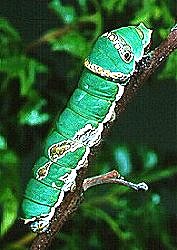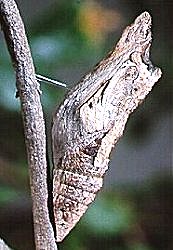|
|
Adult. The female is larger
than the male and the anterior blue
spots of her hindwings (obscured here)
have orange on the outer side as opposed
to yellow in the male. |

Mature larva. Larvae take
about a month to develop, passing
through 4-5 instars and reaching a
maximum size of about 45 mm. |

Pupa. The caterpillar spins a
mat of silk on a twig or leaf of the
host plant to which it attaches the tip
of its abdomen. It pupates within 2
days, first spinning a girdle of silk to
hold itself in a slanting position. The
pupal period lasts 2-3 weeks. |
| Eggs.
The female settles on the leaf of
the host plant and, while still flapping
her wings, bends her abdomen downwards
on to the leaf surface and lays an egg.
Egg development takes about 6 days under
warm conditions. The larva eats it way
out of the egg and then consumes the
remains of the egg shell. |
This is the common, large
black and pale yellow butterfly seen regularly
in gardens in South Africa and also occurring in
natural vegetation. It occurs in open, often
disturbed, habitats throughout Africa south of
the Sahara, as well as on the Cape Verde
Islands, Madagascar and Mauritius (Ackery
et al. 1995). It can be a pest of citrus
saplings in nurseries and, although found on
mature citrus trees, does not cause sufficient
damage to warrant instituting control measures.
On young plants, if larvae and pupae do reach
high levels, the best control procedure is
evidently to simply pick them off by hand.
The Citrus swallowtail
passes through about three generations during
spring, summer and autumn, and the winter period
is usually spent hibernating as a pupa. One can,
however, see the occasional adult during winter.
Natural enemies
- Eggs are parasitised by a small
wasp Ooencyrtus.
- Pupae are parasitised by the wasp
Pteromalus puparum (Hymenoptera:
Pteromalidae).
When the mature larva is
disturbed by, for instance, a bird, it rears up
and uses blood pressure to squeeze out a forked,
finger-like orange-coloured organ called an
osmetrium from just behind its head. Besides
the visual impact of the organ, it also has a
strong smell which acts as a further discentive
to the predator. The smell is evidently caused
by accumulation of substances from the oil
glands in the leaves of the host plant. t is
thought that it is this osmetrium that gave rise
to the term Orange dog for the caterpillar.
The young caterpillars are
protected by camouflage, their black, yellow and
white colouration making them look like bird
droppings.
Host plants (information mainly from
Kroon, 1999)
- Anacardiaceae: Pseudospondias
sp.
- Apiaceae: Archangelica
officinalis; Deverra burchelli, Fennel
Foeniculum vulgare, Blister bush
Peucedanum galbanum, Peucedanum
gummiferum, Pituranthos burchellii.
- Ptaeroxyylaceae: Ptaeroxylon
obliquum (=P. utile)
- Rutaceae: Cape chestnut
Calodendron capense, orange and lemon
trees Citrus spp., Clausena
anisata (=C. inaequalis), Fagara
capensis, Oricia bachmannii, O.
swynnertoni, Teclea natalensis, Teclea
swynnertonii, Toddalia aculeata, Toddalia
asiatica, Vepris lanceolata, Zanthoxylum
capense, Z. delagoense
- Sapindaceae: Hippobromus
pauciflorus (=H. alata)
References
-
Ackery,
P.R., Smith, C.R. and Vane-Wright, R.I.
1995. Carcasson's African Butterflies. An
Annotated Catalogue of the Papilionoidea and
Hesperioidea of the Afrotropical Region.
CSIRO, Australia.
-
Annecke, D.P. & Moran, V.C. 1982. Insects and Mites of Cultivated Plants in South Africa. Butterworths, Durban.
-
Claassens, A.J.M. & Dickson, C.G.C. 1980.
The Butterflies of the Table Mountain
Range. C. Struik Publishers, Cape Town.
-
Clarke, C.A., Dickson,
C.G.C. & Sheppard, P.M. 1963. Larval colour
pattern in Papilio demodocus. Evolution
17: 130-137. [not consulted].
-
Kroon,
D.M. 1999. Lepidoptera of Southern
Africa. Host-plants and other Associations.
A Catalogue. Lepidopterists' Society of
Africa, South Africa.
Photographs by H.L.
O'Heffernan; text by Hamish Robertson |
